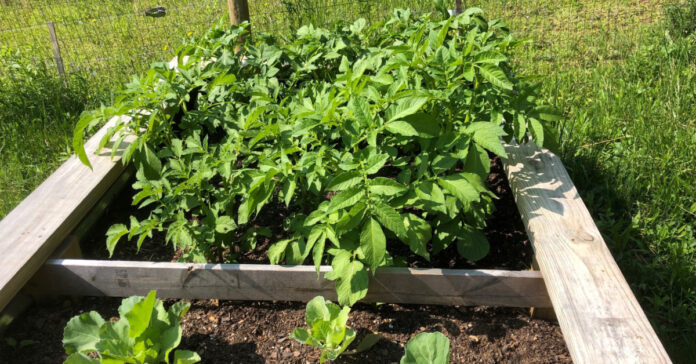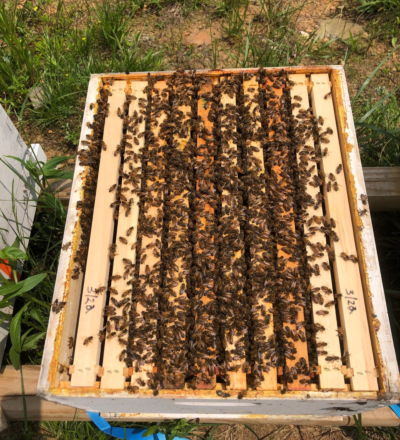
I’m tired. My feet are sore. Twice in the past week I’ve woken up and thought, “I should take an ibuprofen,” but by the time I left the shower and got dressed, I forgot all about it. I’ve been working hard, but I have to admit that it is fulfilling work. I’m not complaining. Those sore feet are just badges of experience.
Here’s May’s list, so far: Cutting, splitting, and stacking firewood. Hauling and burning yard waste. Planting and tending the garden. Weed whacking and mowing. Feeding and tending the bees weekly. Building more beehive components. Plugging the holes in our deck drilled by pesky carpenter bees. Hanging the bat box. Planting shrubs and flowers that will become part of our pollinator garden to help feed the honey bees and wild pollinators. Lopping off small trees growing where we don’t want them to. (It’s important to cut them back while they are small. Wait too long and you need a chainsaw and a helper.) Plus, there’s a never-ending list of things to do.
That’s what homesteading life requires. It takes hard work to be even a little self-sufficient. But the results? I find the results are worth it.
Our Second Spring
At this time last year, I’d built our chicken coop and was still installing the fencing. We didn’t get our chickens or our bees until early June and the hens didn’t graduate from their brooder to the great outdoors until July. This year is a different story; we’ve been busy since the snow melted and the temperatures moderated.
Last year, I got a farmer’s tan, but I didn’t get in shape. This year, the combination of more work and lengthy dog walking is improving my aerobic health, strengthening my legs, and giving me more resilience. I’m climbing further up the mountain without pausing to catch my breath, and I don’t reach for my water bottle as often. I’m averaging an extra 5,000 steps per day this year, and since we can’t walk more than 150 feet without going up or down the mountain, many of those steps are steep.
Physical labor is also coming more easily than it did last year. This year, I can do an entire day of physical labor, get back up and do it again the next day with no problems. Last year, that would have left me exhausted and cranky.
Gaining Valuable Experience
This year, we are able to take advantage of the experience we gained last year. We know what to expect. For example, the apple trees bloomed the same day this year as they did last, despite wildly different weather patterns. Some things, of course, are different. Our April was colder, but our May was warmer. If our last frost date holds, it will be weeks earlier than last year’s.
Last year, everything that happened was new to us. Every plant that popped up was something we hadn’t seen before or didn’t know was there. This year, we have a better idea of what to expect. This time, the tiny wild strawberries won’t be a surprise and we’ll be better prepared to harvest them. We also recognize far more plants on the property, the beneficial ones, the invasive plants we have started to get rid of, and the weeds. We’ve also begun to put our stamp on the place, although it is slow going.
In 2021, I was in a tool acquisition mode. Working on the homestead required tools I never needed in our suburban backyard. Gasoline powered tools like the Stihl weed whacker I upgraded with a metal blade for our thick brambles. A shelf full of tools, insulators, and other parts for maintaining and repairing both electric and woven wire fencing. I have tools dedicated to repairing our plastic water pipe. I have accumulated more fasteners, and I often buy them in the five-pound box. The net result is this year I often have on hand what I need to do the job, including scrap wood. Trips to the hardware store and lumber yard have decreased.
The Early Bee Gets the Honey

I’m also getting to see the advantages of having bees on site on the day in February or early March when the maples bloom and provide the honeybees with their first large-scale source of food. The hives that over-wintered are many times stronger than the nucs I received last June. Even the nucs I got in April of this year have grown rapidly and are ready for the spring honey flow.
The spring flow is starting. A few of the blackberry bushes have gone from tiny white buds to full-fledge blooms, which is the first sign. The black locusts are blooming at lower altitudes and should bloom here within a week or two. Its flowers are supposed to make great honey. I’ve also seen tulip poplars with buds. Tulip poplar honey tends to be dark with a distinctive flavor.
Bees like the trees because each one is like a vertical garden filled with blooms that provide nectar and pollen. It can take hundreds of square feet of pasture to provide a tree’s worth of food to the bees.
We are expecting a burst of unseasonably warm weather over the next few days. I hope it causes an explosion of bee productivity. I removed the entrance reducer on my largest hives to give the bees all the room they need to fly in and out. After all, they’ve got honey supers to fill.
Get Started
I am grateful that we had this year to prepare, acquire knowledge and tools, build infrastructure, and to shape our surroundings before a collapse or other disaster. We are in far better shape to face a disaster today than we would have been a year ago.
If you are thinking of moving to a homestead or a piece of rural property, don’t wait. The sooner you can do it, the better. You can’t take off without a runway, and that’s what last year gave us. The sooner you start, the better because it takes years to see your fruit trees grow and bear fruit. Even most berry bushes take two years to bear. Livestock also needs to grow and mature. Our chickens, for example, didn’t give us our first eggs until November.
On a homestead, you work hard but not immediately seethe results. We can, however, see progress and we can also envision the potential, even though we have not yet fully realized it. We’ve left the runway and raised our landing gear, but we are not yet soaring.
Still, we are on our way.







